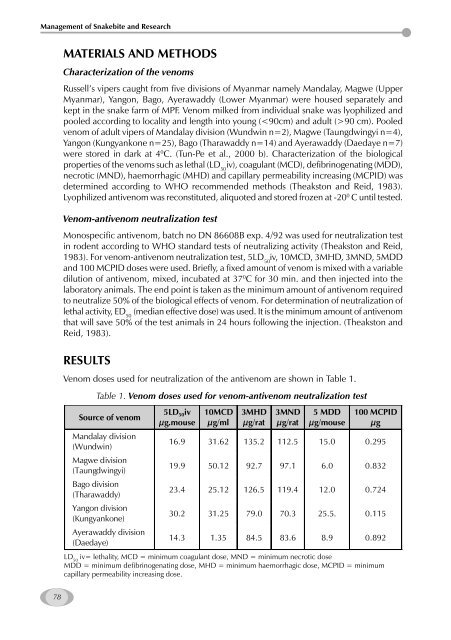Management of Snakebite and Research Management of Snakebite ...
Management of Snakebite and Research Management of Snakebite ...
Management of Snakebite and Research Management of Snakebite ...
You also want an ePaper? Increase the reach of your titles
YUMPU automatically turns print PDFs into web optimized ePapers that Google loves.
<strong>Management</strong> <strong>of</strong> <strong>Snakebite</strong> <strong>and</strong> <strong>Research</strong><br />
78<br />
MATERIALS AND METHODS<br />
Characterization <strong>of</strong> the venoms<br />
Russell’s vipers caught from five divisions <strong>of</strong> Myanmar namely M<strong>and</strong>alay, Magwe (Upper<br />
Myanmar), Yangon, Bago, Ayerawaddy (Lower Myanmar) were housed separately <strong>and</strong><br />
kept in the snake farm <strong>of</strong> MPF. Venom milked from individual snake was lyophilized <strong>and</strong><br />
pooled according to locality <strong>and</strong> length into young (90 cm). Pooled<br />
venom <strong>of</strong> adult vipers <strong>of</strong> M<strong>and</strong>alay division (Wundwin n=2), Magwe (Taungdwingyi n=4),<br />
Yangon (Kungyankone n=25), Bago (Tharawaddy n=14) <strong>and</strong> Ayerawaddy (Daedaye n=7)<br />
were stored in dark at 4 0 C. (Tun-Pe et al., 2000 b). Characterization <strong>of</strong> the biological<br />
properties <strong>of</strong> the venoms such as lethal (LD 50 iv), coagulant (MCD), defibrinogenating (MDD),<br />
necrotic (MND), haemorrhagic (MHD) <strong>and</strong> capillary permeability increasing (MCPID) was<br />
determined according to WHO recommended methods (Theakston <strong>and</strong> Reid, 1983).<br />
Lyophilized antivenom was reconstituted, aliquoted <strong>and</strong> stored frozen at -20 0 C until tested.<br />
Venom-antivenom neutralization test<br />
Monospecific antivenom, batch no DN 86608B exp. 4/92 was used for neutralization test<br />
in rodent according to WHO st<strong>and</strong>ard tests <strong>of</strong> neutralizing activity (Theakston <strong>and</strong> Reid,<br />
1983). For venom-antivenom neutralization test, 5LD 50 iv, 10MCD, 3MHD, 3MND, 5MDD<br />
<strong>and</strong> 100 MCPID doses were used. Briefly, a fixed amount <strong>of</strong> venom is mixed with a variable<br />
dilution <strong>of</strong> antivenom, mixed, incubated at 37 0 C for 30 min. <strong>and</strong> then injected into the<br />
laboratory animals. The end point is taken as the minimum amount <strong>of</strong> antivenom required<br />
to neutralize 50% <strong>of</strong> the biological effects <strong>of</strong> venom. For determination <strong>of</strong> neutralization <strong>of</strong><br />
lethal activity, ED 50 (median effective dose) was used. It is the minimum amount <strong>of</strong> antivenom<br />
that will save 50% <strong>of</strong> the test animals in 24 hours following the injection. (Theakston <strong>and</strong><br />
Reid, 1983).<br />
RESULTS<br />
Venom doses used for neutralization <strong>of</strong> the antivenom are shown in Table 1.<br />
Source <strong>of</strong> venom<br />
M<strong>and</strong>alay division<br />
(Wundwin)<br />
Magwe division<br />
(Taungdwingyi)<br />
Bago division<br />
(Tharawaddy)<br />
Table 1. Venom doses used for venom-antivenom neutralization test<br />
Yangon division<br />
(Kungyankone)<br />
Ayerawaddy division<br />
(Daedaye)<br />
5LD 50iv<br />
µg.mouse<br />
10MCD<br />
µg/ml<br />
3MHD<br />
µg/rat<br />
3MND<br />
µg/rat<br />
5 MDD<br />
µg/mouse<br />
100 MCPID<br />
µg<br />
16.9 31.62 135.2 112.5 15.0 0.295<br />
19.9 50.12 92.7 97.1 6.0 0.832<br />
23.4 25.12 126.5 119.4 12.0 0.724<br />
30.2 31.25 79.0 70.3 25.5. 0.115<br />
14.3 1.35 84.5 83.6 8.9 0.892<br />
LD 50 iv= lethality, MCD = minimum coagulant dose, MND = minimum necrotic dose<br />
MDD = minimum defibrinogenating dose, MHD = minimum haemorrhagic dose, MCPID = minimum<br />
capillary permeability increasing dose.









